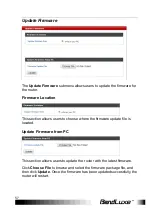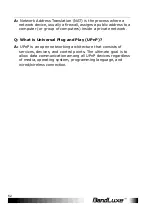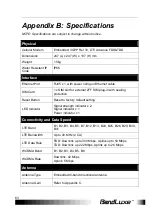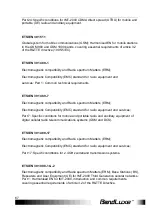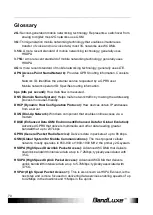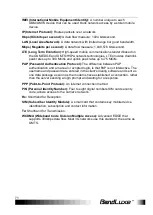
Appendix C: Important Safety Information and Glossary
70
Glossary
2G:
Second-generation mobile networking technology. Represents a switchover from
analog to digital; most 2G networks use GSM.
3G:
Third-generation mobile networking technology that enables simultaneous
transfer of voice and non-voice data; most 3G networks use WCDMA.
3.5G:
A more recent standard of mobile networking technology; generally uses
HSDPA.
3.75G:
A more recent standard of mobile networking technology; generally uses
HSUPA.
4G:
A more recent standard of mobile networking technology; generally uses LTE.
APN (Access Point Name/Network):
Provides GPRS routing information. Consists
of:
Network ID:
Identifies the external service requested by a GPRS user.
Mobile network operator ID: Specifies routing information.
bps (bits per second):
How data flow is measured.
DNS (Domain Name System):
Helps route network traffic by making the addressing
process more user-friendly.
DHCP (Dynamic Host Configuration Protocol):
How devices obtain IP addresses
from a server.
DUN (Dial-Up Network):
Windows component that enables online access via a
modem.
EDGE (Enhanced Data GSM Environment/Enhanced Data for Global Evolution):
Advanced GPRS that delivers multimedia and other data needing greater
bandwidth at up to 237 kbps.
GPRS (General Packet Radio Service):
Delivers data in packets at up to 86 kbps.
GSM (Global System for Mobile Communications):
The most popular cellular
network, mostly operates in 850-900 or 1800-1900 MHz; the primary 2G system.
HSDPA (High Speed Downlink Packet Access):
Advanced WCDMA that delivers
downlink bandwidth intensive data at up to 7.2Mbps; typically associated with
3.5G.
HSUPA (High Speed Uplink Packet Access):
Advanced WCDMA that delivers
uplink bandwidth intensive data at up to 5.76Mbps; typically associated with
3.75G.
HSPA+ (High Speed Packet ):
This is also known as HSPA Evolved, is the
next step and is more focused on delivering data services enabling speeds of up
to 42Mbps in the downlink and 11Mbps in the uplink.


